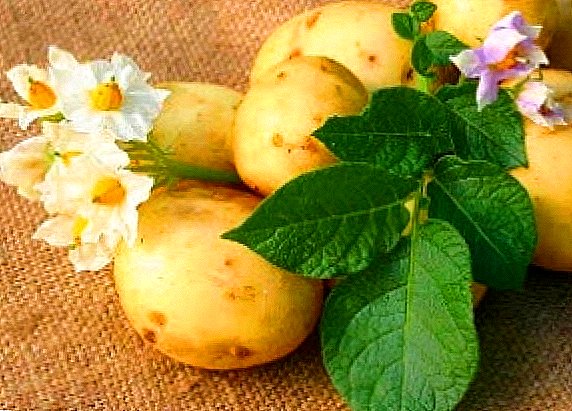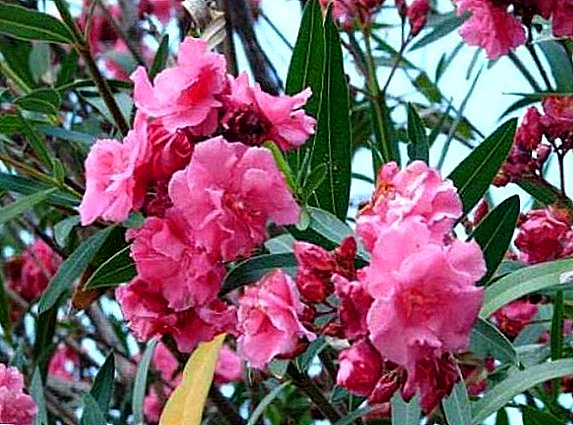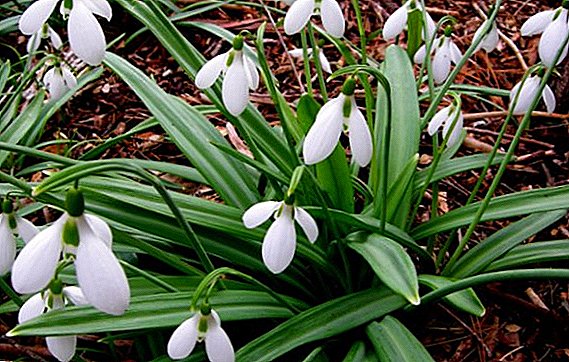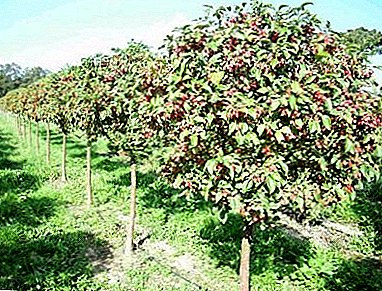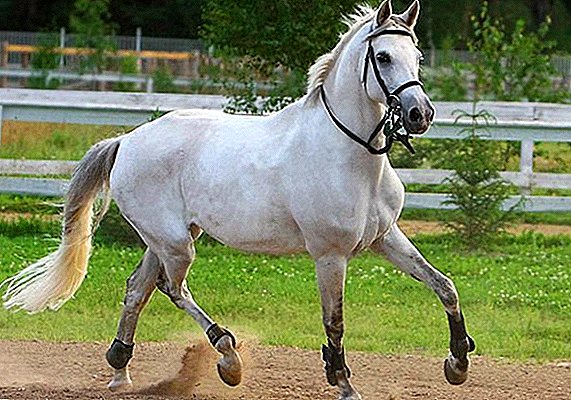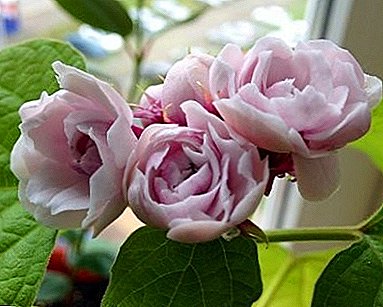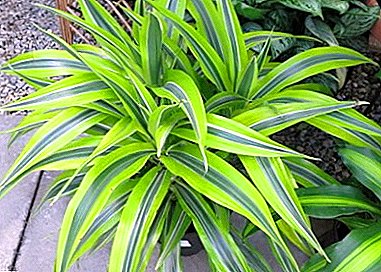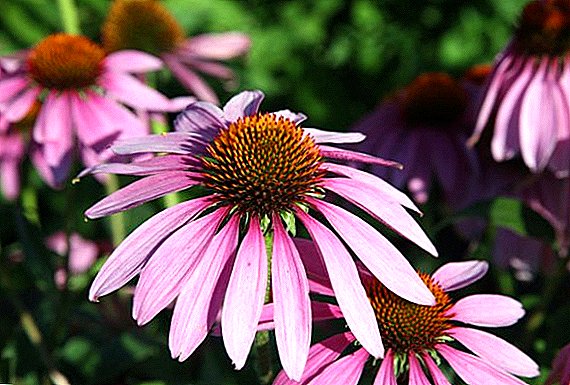 Aphid or plant louse - a very dangerous sucking insect, from the life of which suffers a huge number of diverse cultures. Plants affected by this pest usually stop growing, are oppressed, and often die.
Aphid or plant louse - a very dangerous sucking insect, from the life of which suffers a huge number of diverse cultures. Plants affected by this pest usually stop growing, are oppressed, and often die.
Therefore, when detecting the first signs of a parasite, it is necessary to immediately take measures to eliminate it. This article provides detailed information on how to deal with aphids at the cottage folk remedies.
What is dangerous aphid description pest
 In size, the aphid is miniature, an adult grows to a length of 0.5-2 mm. The body of her egg-shaped, when pressed easily crushed. The insect is represented by a variety of species (about 4000), which differ in appearance.
In size, the aphid is miniature, an adult grows to a length of 0.5-2 mm. The body of her egg-shaped, when pressed easily crushed. The insect is represented by a variety of species (about 4000), which differ in appearance.
On fruit trees, ornamental plants (rose, chrysanthemum), the green aphid is usually parasitic, the legumes and cornflowers are affected by the black aphid. There are still melon, cotton, apple, tobacco, pea, currant, Kalina aphid.
The insect can be with wings and without them. Those individuals that are able to move only on the ground are usually carried by ants.
Aphids are very prolific, multiply rapidly and massively. Every two weeks, a new generation of 150 larvae is born. Therefore, the fight against aphids in the garden area is often associated with great efforts.
Did you know? In one season, plant lice appear 12-18 generations.The main danger for plants is that the aphid bears when it drinks cell sap from buds, leaves, and stems, and with it absorbs all the nutrients. As a result, plant culture fades and may even die in the event of a massive defeat.
Its leaves and tops bend, shoots do not grow. The greatest danger of aphid is for young fragile plants.
Sticky pest excretions (pad), covering the sheet, inhibit the process of photosynthesis. In addition, the aphid is a peddler of dangerous bacteria, viruses and fungi that provoke a variety of diseases.
Most often, the plant louse breeds in uncultivated areas, on soils with an excess of nitrogen or phosphorus deficiency. 
Evidence that your garden or garden was attacked by aphid may be several signs:
- cover the underside of the leaves with the pad;
- the presence under the plant of white scales - discarded insect shells;
- the presence of ant clusters, "ant tracks" around the plant;
- curling and yellowing of the leaves;
- undeveloped twisted buds.
Did you know? Aphids are transported by garden ants. She highlights the sweet pad that these little laborers love to feast on. Therefore, without destroying the anthills, efforts to get rid of aphids will be unsuccessful.When you detect the first symptoms of crop lice crops, you must immediately begin to fight against parasitic insects. The quickest and most effective method to date, of course, is the treatment of plants with insecticidal aphids.
However, since plant lice often attacks vegetable crops, greens, which are eaten, the use of chemistry is an undesirable, extreme, and even unsafe measure. 
Therefore, gardeners and gardeners prefer to use gentle methods, using soap solutions, decoctions of insecticidal plants, tobacco infusions, etc. They also often resort to mechanical processing, which includes the destruction of anthills, stripping of plants (in the initial stage of damage) with strong cold water, collecting insects by hand.
Folk methods of dealing with aphids in the garden
If you decide to carry out the fight against aphids by folk remedies, then you need to know that almost all of them do not destroy parasites, but have only scaring properties. They must be applied three times (at least) at intervals of 7-10 days. The treatment is carried out in the evening, in the absence of precipitation, after the rain it is repeated.
As a prophylactic agent for use in the garden, use a well-proven wood ash infusionthat need to powder the leaves. Prepare it like this: 300 g of ash is boiled in 10 liters of water for half an hour, and 40 g of soap are mixed before direct treatment. 
Ammonia vs aphid
Ammonia is an effective way to get rid of plant lice in the garden. In 10 l diluted with 2 tablespoons of alcohol, and before spraying stir the soap (40 g). After two weeks, the treatment is repeated.
Important! After the use of folk remedies should not immediately carry out watering plants, at least for two or three days.
Soap and aphid
One of the easiest ways to repel an insect is to treat plants with soapy solutions, since the cultures sprayed with them are not suitable for aphids. There are several ways to make them.
Laundry soap from aphids used in the amount of 300 g per 10 liters of water. It is rubbed or finely planed and dissolved in a bucket of water.
Also cooked liquid soap solution (125 g / 10 l). Soap or onion peel can be added to the soap. The solution is sprayed or rubbed on the stems and leaves, especially the places where aphid accumulates - their lower part. 
There are several recipes for preparing a soap solution for aphid processing from green soap:
- in 9 l of water you need to mix well 20 g of mustard powder and 200 g of green soap. Then add copper sulphate (20 g / 1 l);
- 1.5 kg of wood ash mixed with 50 g of green soap, fill with water with a temperature of + 60 ... +70 ºС and insist.
As an antiparasitic agent and at the same time as a top-dressing, processing will serve solution of potash soap. 300 g diluted in water (10 l). They need to spray the upper and lower leaf plates, stems.
Such safe folk remedies as soap solutions help to fight with aphids on roses. Rose bushes in case of a severe injury, spraying with an infusion of 100-200 g of household soap dissolved in 10 liters of water will save sprays.
There are many recipes in which it is recommended to add dishwashing detergent, but gardeners who have already tried this option often complain that it burns the leaves of plants.
How to remove aphid solution of washing powder
Kill aphid is capable of washing powder solution. However, when using it, you need to be extremely careful not to cause burns on the leaves of the plant. Since all the powders are different, the concentration will need to be selected independently. It is recommended to start with a 1% solution.
Important! Before you deal with aphids folk remedies throughout the infected area, it is necessary to test the effect of the solution or decoction on a single plant. Making sure it is safe, after a day you can handle all the landings.
Potato tops against aphids
In addition to household products, there are a number of crops, meetings with which plant louse carefully avoids. What plants does not like aphids? First of all, it is chamomile, marigold, dandelion, wormwood, celandine, yarrow, tansy, garlic, onion, red pepper, horse sorrel, tomatoes, potatoes and others.
From these cultures you can both prepare antiparasitic decoctions and infusions, and plant them near plants, most often suffering from aphid attacks.
Did you know? To scare vegetable lice in close proximity planted garlic, onions, chamomile, mint. From flower cultures aphid does not like begonia, kosmeyu, mallow.Repelling properties has potato topper for the preparation of which: 1 kg of fresh (0.7 kg dry) tops need to chop, pour a bucket of water, insist three hours and strain. For greater efficacy, household soap (30-40 g) is added to the infusion.

Onions and onion peels, how to get rid of aphids folk remedies
Afraid aphid and treatments infusion of onions and onion peel. They are prepared as follows:
- 200 g of onion peel need to insist 12-15 hours in 10 liters of warm water, then strain;
- Onion peel mixed with citrus peel, pour boiling water, stand for three days, strain, and dilute with water before each spraying;
- 200 g of onion heads chop, insist in 10 liters of water 12-18 hours, strain, add 40 g of soap.
Important! When using herbal decoctions and infusions it is necessary to take into account that in large doses and high concentrations they can burn the leaves. Some of them are dangerous for both plant lice and other insects, and may also pose a risk to human health.

How to deal with aphid chamomile infusion
Fight with plant lice helps and pharmaceutical chamomile infusion. For its preparation will need 1 kg of dry leaves and inflorescences. They insist 12 hours in 10 liters of water. Then filter through gauze. For one treatment, prepare a solution, diluting chamomile infusion with water in a ratio of 1: 3 and adding soap (40 g / 10 l).
Use of conifers in the fight against aphids
Aphids do not tolerate coniferous smell, so the fight against it can be carried out using such folk remedies as decoctions and infusions of pine needles.
During the week should insist 2 kg of needles in 10 liters of water, stirring the composition every day. Store the infusion should be in a dark place. After a week, it must be drained and diluted with water in a ratio of 1: 3 (for spraying) before use, and diluted in a ratio of 1: 1 for inter-row spacing.
You can make a solution of pharmaceutical coniferous concentrate: 4 tbsp. spoons per 10 liters of water.
The fight against tobacco shag and tobacco
The insecticidal properties of tobacco allow it to be used to rescue aphids. Tobacco, tobacco dust and tobacco used in the preparation of infusions, decoctions and solutions.
Infusion: Chop 200 g of (dry) tobacco leaves, pour 5 liters of water, leave for 24 hours, bring the volume of liquid to 10 liters, boil for two hours over low heat.
Broth: Pour one part of tobacco dust with 10 parts of water, leave for 48 hours, dilute with water 1: 3 and add soap (40 g / 10 l).
Important! When using products prepared on the basis of tobacco, it is necessary to observe the same personal safety measures as in the treatment of chemical compounds.

One of the favorite plants of plant lice is viburnum. Usually it settles on it massively, tightly clinging to the branches of the plant. Therefore, very often gardeners are interested in the question how to deal with aphids on Kalina.
You can try to apply this solution: 1 cup of tobacco dust or fringe, 1 cup of wood ash, 1 tbsp. spoons of liquid soap, 1 tbsp. spoons of mustard, you must pour 2-3 liters of water with a temperature of + 70 ... + 80 ° C. Insist for two hours and strain. Then, bring the amount of water to 10 liters. Spray should be the bottom side of the leaf plate, performing processing three times at intervals of 6-8 days.
Plants, birds and insects against aphids
Aphids have natural enemies - ladybugs, praying mantis, wasps, ground beetles, bugs. Love to eat vegetable lice and birds: sparrows, tits, linnet, blood orangecakes, robins. Therefore, for the purpose of prevention and control, it is necessary to attract birds in the garden and orchard, by constructing for them feeders, drinking bowls, nests. Insects can be lured by planting plants that they love, such as carrots, parsley. 
We told you about a variety of popular methods of dealing with aphids.. Among them there will definitely be those that are suitable for you and your plants, thereby helping to permanently banish aphids from the site. Finally, here are some more recommendations regarding the proper use of folk remedies on different plant species.
So, fruit trees and shrubs are treated three times: in the budding phase, after it has bloomed and 14 days before harvest. Berries are sprayed before flowering and after harvesting. The last processing of vegetable crops should be made a month before picking vegetables.
When applying infusions from tops of potatoes, tomato, tobacco, henbane, datura fruit can not be eaten after spraying for another 10 days.


